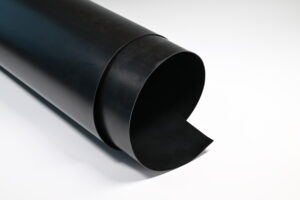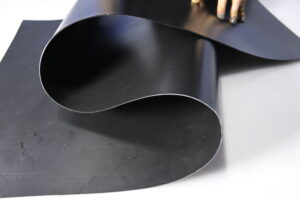#Geotextile #Geomembrane #Geotechnical #GCL #Geogrids
what is geomembrane?
Geomembrane is a man-made material used for environmental and water protection, usually made of high-density polyethylene (HDPE), linear low-density polyethylene (LLDPE), polypropylene (PP) and other plastics. It has high anti-seepage performance and can be used in many fields such as landfills, hazardous waste treatment facilities, reservoirs, canals, and sewage treatment plants.
Geomembrane can be used as a separate anti-seepage layer or as a part of composite materials, such as geogrid plus geomembrane, sand pad plus geomembrane, etc. Laying Geomembrane in the soil usually requires certain pretreatments, such as leveling the soil surface and removing sharp objects that may damage the Geomembrane.
In general, Geomembrane has a wide range of applications in environmental protection, water conservancy engineering, construction engineering and other fields.

The main manufacturing process of geomembrane includes the following steps:
Material preparation: select high-density polyethylene, linear low-density polyethylene, polypropylene and other plastic materials, and then mix them in proportion.
Extrusion production: put the mixed plastic material into the extruder, extrude it into a film through high temperature and high pressure of the extruder, and add necessary additives, such as antioxidants, ultraviolet absorbers, etc., during the extrusion process to improve Geomembrane properties.
Surface treatment: The surface of the geomembrane needs to be processed. Usually, the surface is calendered with a roller or a scraper to obtain a smooth surface.
Winding and packaging: the geomembrane is rolled up, and it is packaged and labeled for storage and transportation.
It should be noted that various indicators and chemical components need to be strictly controlled during the production process of geomembrane to ensure that the product meets the relevant national standards and requirements. At the same time, when installing and using the geomembrane, it is also necessary to follow the corresponding specifications and requirements to ensure that it can exert the best anti-seepage effect.
Geomembrane is a widely used civil engineering material, usually made of high-density polyethylene, linear low-density polyethylene, polyvinyl chloride and other materials. It is favored by the fields of civil engineering and environmental protection, and is mainly used for anti-seepage, isolation, protection and reinforcement in water conservancy and electric engineering, municipal engineering, environmental engineering, road engineering and other fields.

What are the advantages of geomembrane?
Strong anti-seepage performance: It has good anti-penetration and chemical corrosion resistance, which can effectively isolate and protect pollutants in the project.
Wide range of application: It can be applied to different types of land and environments, such as pits, dikes, dams, ponds, reservoirs, rivers, coasts, etc.
Good aging resistance: It has good aging resistance, and it still maintains good performance after years of wind and rain.
Convenient construction: The construction is simple and convenient, and on-site splicing can be carried out by cutting, seaming and hot melting, which improves the construction efficiency and project quality.
Low cost: Compared with traditional anti-seepage materials, geomembrane has lower cost and longer service life, and its economic benefits are obvious.
In short, geomembrane is a civil engineering material with wide application, excellent performance, convenient construction and low cost. It has become one of the indispensable and important materials in modern construction.
Geomembrane is a kind of geosynthetic material, which is mainly used for waterproofing, anti-seepage and isolation. It is usually off-white or black in appearance, soft in texture, and has certain toughness and wear resistance.
In modern engineering construction, geomembranes are widely used in roads, dams, drainage ditches, landfills, water conservancy projects, marine development and other fields.
about us
Shandong Tianhai is a well-known chemical company in China, headquartered in Zhangdian District, Zibo City, Shandong Province. Founded in 1994, the company is mainly engaged in the R&D, production and sales of hydrofluoric acid, fluoride, polyol, silicone and other products. The company has successively passed ISO9001 quality management system, ISO14001 environmental management system and OHSAS18001 occupational health and safety management system certification, and won honors such as “China Excellent Private Enterprise”, “Shandong Province Famous Brand Product” and “Shandong Province Innovative Enterprise”.
Shandong Tianhai’s products are widely used in metallurgy, petrochemical, electronics, glass and other industries, as well as in agriculture, medicine, and daily chemical fields. Among them, hydrofluoric acid, fluoride, polyols and other products have a relatively high market share and good reputation in the domestic market. Shandong Tianhai Company has always adhered to scientific and technological innovation, continuously improved product quality and production technology level, and is committed to providing customers with more high-quality and reliable chemical products and services.
WhatsApp:+86 183 0531 0266
Email:info@tinhygeosynthetics.com
Web:tinhygeosynthetics.com


